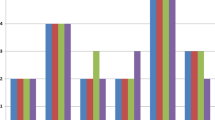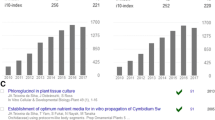Abstract
The h-index is becoming a reference tool for career assessment and it is starting to be considered by some agencies and institutions in promotion, allocation, and funding decisions. In areas where h indices tend to be low, individuals with different research accomplishments may end up with the same h. This paper proposes a multidimensional extension of the h index in which the conventional h is only the first component. Additional components of the multidimensional index are obtained by computing the h-index for the subset of papers not considered in the immediately preceding component. Computation of the multidimensional index for 204 faculty members in Departments of Methodology of the Behavioral Sciences in Spain shows that individuals with the same h can indeed be distinguished by their values in the remaining components, and that the strength of the correlation of the second and third components of the multidimensional index with alternative bibliometric indicators is similar to that of the first component (i.e., the original h).
Similar content being viewed by others
References
Anderson, T. R., Hankin, R. K. S., Killworth, P. D. (2008), Beyond the Durfee square: Enhancing the h-index to score total publication output. Scientometrics, 76: 577.
Batista, P. D., Campiteli, M. G., Kinouchi, O., Martinez, A. S. (2006), Is it possible to compare researchers with different scientific interests? Scientometrics, 68: 179.
Bornmann, L., Daniel, H.-D. (2005), Does the h-index for ranking of scientists really work? Scientometrics, 65: 391.
Burrell, Q. L. (2007), Hirsch index or Hirsch rate? Some thoughts arising from Liang’s data. Scientometrics, 73: 19.
Costas, R., Bordons, M. (2008), Is g-index better than h-index? An exploratory study at the individual level. Scientometrics, 77: 267.
Egghe, L. (2006a), An improvement of the h-index: The g-index. ISSI Newsletter, 2(1): 8.
Egghe, L. (2006b), Theory and practise of the g-index. Scientometrics, 69: 131.
García-Pérez, M. A. (2009), The Hirsch h index in a non-mainstream area: Methodology of the Behavioral Sciences in Spain. Spanish Journal of Psychology, in press.
Hirsch, J. E. (2005), An index to quantify an individual’s scientific research output. Proceedings of the National Academy of Sciences of the U.S.A., 102: 16569.
Hirsch, J. E. (2007), Does the h index have predictive power? Proceedings of the National Academy of Sciences of the U.S.A., 104: 19193.
Iglesias, J. E., Pecharromán, C. (2007), Scaling the h-index for different scientific ISI fields. Scientometrics, 73: 303.
Imperial, J., Rodríguez-Navarro, A. (2007), Usefulness of Hirsch’s h-index to evaluate scientific research in Spain. Scientometrics, 71: 271.
Kelly, C. D., Jennions, M. D. (2006), The h index and career assessment by numbers. Trends in Ecology and Evolution, 21: 167.
Kelly, C. D., Jennions, M. D. (2007), H-index: Age and sex make it unreliable. Nature, 449: 403.
Kosmulski, M. (2006), A new Hirsch-type index saves time and works equally well as the original h-index. ISSI Newsletter, 2(3): 4.
Lehmann, S., Jackson, A. D., Lautrup, B. E. (2007), Measures for measures. Nature, 444: 1003.
Lehmann, S., Jackson, A. D., Lautrup, B. E. (2008), A quantitative analysis of indicators of scientific performance. Scientometrics, 76: 369.
Liang, L. (2006), h-index sequence and h-index matrix: Constructions and applications. Scientometrics, 69: 153.
van Raan, A. F. J. (2006), Comparison of the Hirsch-index with standard bibliometric indicators and with peer judgment for 147 chemistry research groups. Scientometrics, 67: 491.
RODRÍGUEZ NAVARRO, A., IMPERIAL RÓDENAS, J. (2007), Índice h. Guía Para la Evaluación de la Investigación Española en Ciencia y Tecnología Utilizando el Índice h. Madrid: Consejería de Educación de la Comunidad de Madrid. Retrieved January 8, 2009, from http://www.madrimasd.org /informacionidi/biblioteca/publicacion/doc/33_indiceh.zip.
Rousseau, R. (2008), Reflections on recent developments of the h-index and h-type indices. Collnet Journal of Scientometrics and Information Management, 2: 1.
Ruane, F., Tol, R. S. J. (2008), Rational (successive) h-indices: An application to economics in the Republic of Ireland. Scientometrics, 75: 395.
Saad, G. (2006), Exploring the h-index at the author and journal levels using bibliometric data of productive consumer scholars and business-related journals respectively. Scientometrics, 69: 117.
Schreiber, M. (2007), A case study of the Hirsch index for 26 non-prominent physicists. Annalen der Physik, 16: 640.
Schubert, A. (2009), Using the h-index for assessing single publications. Scientometrics, in press.
Sidiropoulos, A., Katsaros, D., Manolopoulos, Y. (2007), Generalized Hirsch h-index for disclosing latent facts in citation networks. Scientometrics, 72: 253.
Taber, D. F. (2005), Quantifying publication impact. Science, 309: 2166.
Vinkler, P. (2007), Eminence of scientists in the light of the h-index and other scientometric indicators. Journal of Information Science, 33: 481.
Wendl, M. C. (2007), H-index: However ranked, citations need context. Nature, 449: 403.
Zhivotovsky, L. A., Krutovsky, K. V. (2008), Self-citation can inflate h-index. Scientometrics, 77: 373.
Author information
Authors and Affiliations
Corresponding author
Rights and permissions
About this article
Cite this article
García-Pérez, M.A. A multidimensional extension to Hirsch’s h-index. Scientometrics 81, 779–785 (2009). https://doi.org/10.1007/s11192-009-2290-1
Received:
Published:
Issue Date:
DOI: https://doi.org/10.1007/s11192-009-2290-1




